Share

The Storytelling Lab
The Sequencing of Your Stories
Season 5, Ep. 64
•
On this episode of The Storytelling Lab, Rain addresses a very important aspect of effective storytelling: sequencing. Rain highlights why the order of your story's events are crucial to executing your brand storytelling strategy and even tells us a tale of his own! This episode is perfect for anyone wanting to dive deeper into WHY stories are sequenced the way that they are and how proper sequencing can heighten the connection with your prospective audience or customers.
More episodes
View all episodes
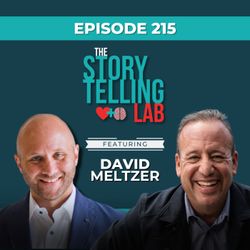
215. The Billion-Person Mission That Started With Bankruptcy with David Meltzer
26:47||Season 14, Ep. 215“I was made from mistakes. I was promoted, protected, loved, and perfected by them.” — David MeltzerAfter losing $100 million and hitting rock bottom, David Meltzer rebuilt his life and his business around a mission to empower over 1 billion people to be happy.In this episode, Rain Bennett sits down with David to explore how storytelling became the vehicle for that transformation.David opens up about the bankruptcy he once hid from the world, the emotional healing that followed, and the new definition of success that changed everything. They talk about the myth of “give more, get more,” the strategic use of vulnerability, and how to build a brand rooted in service and joy.If you’ve ever struggled to see the upside in your darkest moments, this conversation will show you how to flip the script and turn your pain into purpose.In this episode, you will learn to:Reframe failure as the foundation for your most powerful storyCreate a happiness-driven business model that serves and scalesEmbrace vulnerability to build real trust and connectionShift from ego-based identity to a mission-based lifeTeach your team to lead with empathy, clarity, and consistencyFollow David on:LinkedInInstagramTikTokYouTubeor visit his website, HERE!And for more storytelling tips and tricks,Visit rainbennett.com or thestorytellinglabpodcast.comFollow on TikTok @chiefstorytellingofficerFollow on Twitter @rainbennettFollow on Instagram @rainbennettFollow on Facebook @thestorytellinglab Subscribe to the YouTube Channel
214. How a Local Utility Company Became a Storytelling Powerhouse with Krystal Phillips
50:36||Season 14, Ep. 214“It’s not just about keeping the lights on—it’s about building a relationship with the people at the end of the line.” — Krystal Phillips, JO-EMCStorytelling isn’t just for trendy brands or startups.In this episode, Rain sits down with Krystal Phillips, Communications and Community Relations Manager at Jones-Onslow EMC, to explore how a rural electric co-op built a storytelling culture that would rival any big tech brand.Krystal reveals the behind-the-scenes thinking that led a utility company to invest in heartfelt video stories, internal leadership programs, and community-first content. Together, they unpack how to measure storytelling ROI when you can’t rely on sales, how buy-in from leadership transforms culture, and why authenticity matters more than production value.This episode is a must-listen for anyone working in “unsexy” industries who wants to make storytelling their competitive advantage.In this episode, you will learn to:Harness storytelling as a strategic tool, even in “boring” or highly regulated industriesBuild team buy-in by grounding your strategy in community and trustEstablish internal programs that create a pipeline of storytellers inside your organizationHumanize your brand with stories that foster empathy and emotional connectionMeasure the real ROI of storytelling beyond dollars and metricsFollow Krystal on:LinkedInInstagramor visit the JO-EMC website, HERE!And for more storytelling tips and tricks,Visit rainbennett.com or thestorytellinglabpodcast.comFollow on TikTok @chiefstorytellingofficerFollow on Twitter @rainbennettFollow on Instagram @rainbennettFollow on Facebook @thestorytellinglab Subscribe to the YouTube Channel
213. Storytelling That Builds Trust Across Any Organization with Salvatore Manzi
55:02||Season 14, Ep. 213“A shared narrative means everyone in the organization is speaking about the story in the same way.” — Salvatore ManziIf every person on your team is telling a different version of your brand story, you don’t have a marketing problem—you have a clarity crisis.In this episode, communication strategist and author Salvatore Manzi joins Rain to break down how to build a shared narrative that aligns everyone in your organization.From CEOs to customer service reps, consistency in storytelling builds trust, clarity, and emotional resonance. Salvatore shares actionable frameworks for clear and compelling communication, how to blend personal and brand narratives, and why metaphors are essential tools for influence.Whether you're leading a nonprofit or a global brand, this episode will sharpen your storytelling and unify your message.In this episode, you will learn to:Align your entire team behind a unified narrative that eliminates confusionUse storytelling frameworks to turn complex data into meaningful messagesBuild trust with audiences by integrating vulnerability into your leadership voiceAvoid common communication pitfalls in both nonprofits and STEM-driven businessesApply the “problem, process, outcome” structure to make your stories more actionableFollow Salvatore on:LinkedInInstagramor visit his website, HERE!And for more storytelling tips and tricks,Visit rainbennett.com or thestorytellinglabpodcast.comFollow on TikTok @chiefstorytellingofficerFollow on Twitter @rainbennettFollow on Instagram @rainbennettFollow on Facebook @thestorytellinglab Subscribe to the YouTube Channel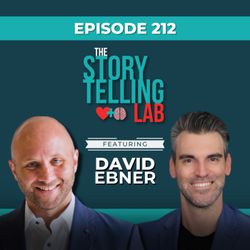
212. How to Use Storytelling to Fuel a Content Engine with David Ebner
54:08||Season 14, Ep. 212“A message map is the most underutilized resource for marketers.” — David EbnerWhat if the reason your marketing isn’t working has nothing to do with the content itself, but everything to do with the foundation it’s built on?In this episode, Rain sits down with David Ebner, founder of Content Workshop and one of the clearest voices in content strategy, to unpack why most brand storytelling falls flat. They explore the concept of the message map, how to build a storytelling system that scales, and why trust is the most important marketing metric you’re probably not tracking.David also opens up about how his background in creative writing fuels his approach to business storytelling, what metrics actually matter, and how emotion creates longevity in brand relationships.Whether you're a solopreneur or scaling a team, this episode will challenge the way you think about content and give you a smarter path forward.In this episode, you will learn to:Apply the power of a message map to bring structure and purpose to your contentUse storytelling as a system, not just a one-off tacticRethink your marketing metrics and focus on what truly builds trustLeverage long-form cornerstone content to fuel your daily outputAvoid burnout by shifting from production obsession to strategic clarityFollow David on:LinkedInor visit the Content Workshop website, HERE!And for more storytelling tips and tricks,Visit rainbennett.com or thestorytellinglabpodcast.comFollow on TikTok @rainbennett.storyellerFollow on Twitter @rainbennettFollow on Instagram @rainbennettFollow on Facebook @thestorytellinglab Subscribe to the YouTube Channel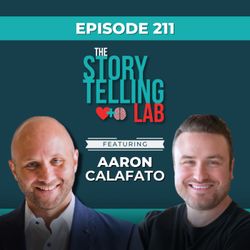
211. How Personal Stories Build Public Trust in Just 7 Minutes with Aaron Calafato
01:09:45||Season 14, Ep. 211“The shortest distance between two souls is a story.” — Aaron CalafatoAaron Calafato doesn’t just teach storytelling—he lives it. In this episode, we dive into what it really means to lead with story, both as an artist and a business strategist. Aaron shares how he built an audience (and a business) by showing up authentically and consistently, telling personal stories that are never just about him. We discuss the fine line between self-expression and self-indulgence, how personal narratives can unlock professional growth, and why he refuses to monetize his podcast Seven Minute Stories. This conversation is full of heart, humor, and hard-earned wisdom for anyone trying to build trust through story.In this episode, you will learn to:Identify the differences between storytelling as a gift and storytelling as a performanceUse personal stories to create trust, not just attentionBalance art and business while staying true to your valuesBuild long-term brand equity through consistent storytellingAvoid the trap of trying to be “cool” when what people really want is connectionFollow Aaron on:YouTubeInstagramor listen to his show, Seven Minute Stories, HERE!And for more storytelling tips and tricks,Visit rainbennett.com or thestorytellinglabpodcast.comFollow on TikTok @rainbennett.storyellerFollow on Twitter @rainbennettFollow on Instagram @rainbennettFollow on Facebook @thestorytellinglab Subscribe to the YouTube Channel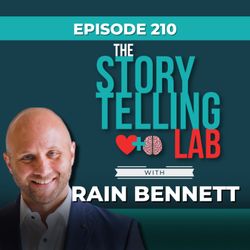
210. Building a Narrative Operating System that Scales Your Business
24:11||Season 14, Ep. 210“A story is a single arc of transformation. A narrative is the thread that connects them all.” — Rain BennettMost businesses think their biggest challenge is marketing. But what if the real issue is story misalignment?In this solo episode, Rain Bennett introduces the Narrative Operating System—a strategic framework designed to bring your brand's stories into alignment across every department: from vision and mission to product, marketing, advertising, and sales.This isn't just a branding tool. It’s a storytelling system that ensures your internal culture and external messaging work in harmony.Rain breaks down each layer of the system and shows how companies can create a brand people don’t just buy from, but they believe in.You’ll learn why most teams default to their own version of the story, how that causes confusion and erodes trust, and how the Chief Storytelling Officer role solves that. If you’ve ever felt like your message was scattered or your content inconsistent, this episode gives you a clear roadmap to fix it for good!In this episode, you will learn to:Align every department with one cohesive brand narrativeBuild a storytelling system that fuels marketing, product, and salesUnderstand the difference between story and narrative—and why it mattersUse narrative to drive consistency, connection, and long-term loyaltyEmbrace the CSO role as the protector of your brand’s story DNAFor more storytelling tips and tricks,Visit my website rainbennett.com or thestorytellinglabpodcast.comFollow me on TikTok @rainbennett.storyellerFollow me on Twitter @rainbennettFollow me on Instagram @rainbennettFollow me on Facebook @thestorytellinglab Subscribe to my Youtube Channel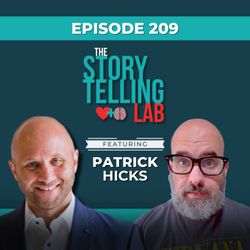
209. How the Soundtracks of Our Lives Shape who We Become with Patrick Hicks
01:04:25||Season 14, Ep. 209“If it makes me curious, then maybe it’ll make someone else curious, too.” — Patrick HicksWhat started as a 30-day content challenge became a storytelling movement powered by rock, raw honesty, and curiosity.In this episode of The Storytelling Lab, Rain Bennett speaks with Patrick Hicks, creator of a viral TikTok account (@patrickhicksmusic), where he tells the stories behind the songs that shaped our lives. With over half a million followers and a growing book project, Patrick has built a creator career that feels authentic, soulful, and sustainable.They discuss how Patrick’s background in marketing, music, and punk DIY culture gave him the tools to grow his audience without losing his voice. You’ll hear how he balances content creation with a full-time job, why he never polishes his videos, and how he structures stories to connect emotionally—without chasing algorithms.This episode is a masterclass in following your curiosity, honoring your influences, and building something meaningful on your own terms.In this episode, you will learn to:Turn a simple idea into a large, loyal audience by following your own curiosityTell better stories by pairing emotional narratives with musical memoryStructure short-form content that resonates without being overproducedBuild trust and authenticity by leaning into your quirks and imperfectionsBalance creative pursuits with real life while still growing your platformFollow Patrick on:TikTokInstagramor subscribe to his Substack here!And for more storytelling tips and tricks,Visit rainbennett.com or thestorytellinglabpodcast.comFollow on TikTok @rainbennett.storyellerFollow on Twitter @rainbennettFollow on Instagram @rainbennettFollow on Facebook @thestorytellinglab Subscribe to the YouTube Channel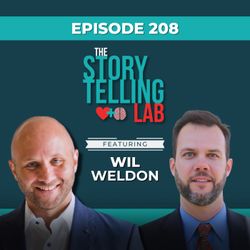
208. Interviewing as a Tool for Trust, Healing, and Human Connection with Wil Weldon
51:34||Season 14, Ep. 208"Interviewing is not about taking something—it's about helping them be more of who they are." — Wil WeldonWhat if the key to more powerful storytelling lies not in your editing skills—but in your ability to deeply listen?In this soul-stirring episode, Rain Bennett talks with Wil Weldon, a video journalist, former massage therapist, and Reiki practitioner who’s developed a holistic approach to interviewing called Heart-Forward Storytelling.They dive into Wil’s new book INNERviewing: Heart-Forward Storytelling and Holistic Communication, which teaches storytellers, coaches, marketers, and everyday humans how to create space for transformational conversations. You’ll learn how principles of energy transfer, intention, and trust can improve your interviews—not just on camera, but in life.From family storytelling to trauma-informed listening, this episode reminds us that storytelling is more than performance—it's connection at its deepest level.In this episode, you will learn to:Create deeper interviews by minimizing your ego and agendaApply Reiki-inspired principles to your communication processBuild trust and energy in storytelling relationships without manipulationPreserve your family’s legacy through intentional, heart-centered conversationsRedefine interviewing as a collaborative, healing experience—not an extractive oneFor more storytelling tips and tricks,Visit rainbennett.com or thestorytellinglabpodcast.comFollow on TikTok @rainbennett.storyellerFollow on Twitter @rainbennettFollow on Instagram @rainbennettFollow on Facebook @thestorytellinglab Subscribe to the YouTube Channel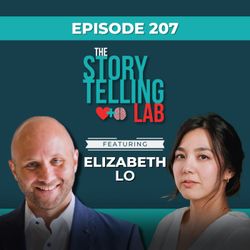
207. The Ethics of Filming Real Love Triangles in Mistress Dispeller with Elizabeth Lo
57:04||Season 14, Ep. 207"I wanted each character to be complex enough and sympathetic enough that there's some deep reason you could identify in yourself." — Elizabeth LoHow do you tell a story that's intimate, ethically complicated, and rooted in real-life secrecy—without exploiting your subjects?In this episode, Rain Bennett speaks with acclaimed documentary filmmaker Elizabeth Lo, director of Mistress Dispeller, one of the most talked-about films this year.The film follows a professional “mistress dispeller” in China hired to break up extramarital affairs on behalf of betrayed spouses—yes, it’s exactly what it sounds like.Elizabeth opens up about how she gained the trust of real people in real love triangles, how she balanced empathy with narrative clarity, and how she created emotional tension through stillness instead of sensationalism.They discuss ethical gray areas, building documentaries without control, and letting stories unfold naturally while still crafting a cohesive arc. If you’re a nonfiction filmmaker or just someone interested in telling hard stories with humanity, this episode is a must-listen.In this episode, you will learn to:Earn the trust of documentary subjects by building long-term, authentic relationshipsLet stories unfold naturally instead of forcing a narrative structureNavigate ethical storytelling with sensitive, real-world materialUse stillness and silence to create emotional tensionAlign your personal values with the stories you choose to tellFor more storytelling tips and tricks,Visit rainbennett.com or thestorytellinglabpodcast.comFollow on TikTok @rainbennett.storyellerFollow on Twitter @rainbennettFollow on Instagram @rainbennettFollow on Facebook @thestorytellinglab Subscribe to the Youtube Channel